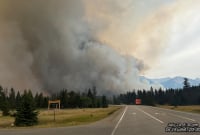There's not a lot that can be done other than "sit and wait" for a landslide to clear that is blocking British Columbia's Chilcotin River, Chief Joe Alphonse of the Tsilhqot'in First Nation says.
Alphonse said Friday that a landslide that dammed the river two decades ago burst in about four days, but this latest slide is "a lot larger than it was last time."
"This is not really anything new for us," he said. "There's not a lot we can do."
Alphonse said there's not much use in worrying about what may happen, other than hoping people don't get too close to the water should it rapidly rise after the debris clears.
He said a salmon run expected late next week has already likely been affected and "that run is now in jeopardy and that's very concerning for us."
"We should have a fishery going on right now," he said. "We are dependent on salmon runs for healthy living. That's the main source of food for our people."
The slide dammed the river early Wednesday, creating a pile of debris 30 metres deep and more than 600 metres long. The river is a tributary of the Fraser River, where the salmon bound for the Chilcotin are making their way upstream.
A massive lake, described as several kilometres long, sits behind the dam of debris.
For Chief Willie Sellars of the Williams Lake Indian Band, the uncertainty of how the landslide will give way is a key concern.
Sellars has been over the slide in a helicopter for two days in a row and said the water behind the dam doubled in size from Wednesday to Thursday and it continues to build.
"And it's eventually going to get to this place where it starts overtopping the slide. And, you know, all the experts in all the calls and the feedback that we continue to hear is, is nobody really knows what is going to happen."
Scenarios include the dam releasing all at once, or the water could trickle through, or the lake behind the dam will top the slide and allow the river flow to resume, he said.
"But there is this massive body of water that is building on the one side of that slide. And it's scary," he said.
"It's hard to describe in words how massive this slide is, and how devastating it is."
The B.C. government issued a statement late Thursday saying the landslide material is composed of sands, silts and clays, which are "susceptible to rapid erosion."
It said provincial personnel are monitoring the site south of Williams Lake around the clock, with help from drones and helicopters.
"The focus is on learning as much as possible about when and how the water is most likely to be dispersed to the Chilcotin River," it said.
The government statement said there is "no anticipated timeline" for when the water may overtop or burst through the landslide material, though regional officials have said a release could be imminent.
Margo Wagner, chair of the Cariboo Regional District, told a news briefing on Thursday that a release could be expected within one to two days.
Evacuation orders span 107 square kilometres along the Chilcotin River, and officials say the slide poses an "immediate danger to life and safety."
Sellars said the river has "massive cultural significance" for all the First Nations in the area, and he also has concerns for the impacts downstream if the dam bursts.
"And really, it's hundreds of communities that are impacted and located along the Fraser (River)," he said.
B.C. Minister of Emergency Management Bowinn Ma said on Thursday that if the dam breaks it's possible that dozens of evacuation orders and alerts would be issued as a surge of water moves down the Chilcotin River and into the Fraser River, which empties into the Strait of Georgia in Metro Vancouver.
Sellars said his community is about 45 minutes away from the slide, so an evacuation of the community likely won't be necessary.
"(There's) a lot of history, former village sites, burial grounds, and we need to make sure that we're doing everything we can to document and protect those," he said.
The Tsilhqot'in National Government issued a statement Thursday, declaring a local emergency and warned people to stay away from the river.
The statement said the slide happened upstream of Nagwentled, also known as Farwell Canyon.
The B.C. government’s geographical names data base says Nagwentled in Tsilhqot’in roughly translates to "landslides across the river."
This report by The Canadian Press was first published Aug. 2, 2024.




Comments